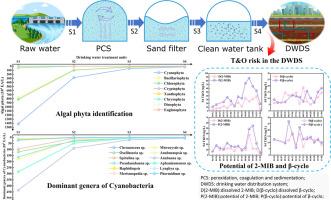Algae penetration and taste and odor compounds production in drinking water treatment plants: seasonal variations and risk assessment
IF 6.3
2区 环境科学与生态学
Q1 ENVIRONMENTAL SCIENCES
引用次数: 0
Abstract
In the conventional water treatment process, algae have a propensity to breach the filter barriers and potentially seep into the water distribution system, leading to an elevation in taste and odor compounds (T&O compounds). This investigation delved into the seasonal fluctuations of algae penetration and the production of T&O compounds within the treatment units of Reservoir Water Plant 1 (W1) and River Water Plant 2 (W2). The findings indicated that despite the application of the ‘pre-oxidation, coagulation and sedimentation (PCS), sand filtration, and disinfection’ process, certain robust-walled filamentous Cyanobacteria, Bacillariophyta species, and small Chlorophyta genera managed to bypass the filters. The leakage of algal cells during autumn at W1 was particularly striking, with a peak of 1,170,000 cells/L. The concurrent assessment of the potential for T&O compound formation revealed an alarming high potential for 2-methylisoborneol (2-MIB) in the water leaving the plants, with concentrations soaring to 197.20 ng/L at W1 in autumn and 54.78 ng/L at W2 in summer. This underscores the significant capacity of residual algal cells to generate T&O compounds. Tracking the retention and penetration dynamics of algal cells across each drinking water treatment stage is crucial for surface water treatment facilities to develop effective operational and management strategies, thereby enhancing the safety and quality of drinking water for the end consumer.

饮用水处理厂中藻类渗透和味道和气味化合物的产生:季节变化和风险评估
在传统的水处理过程中,藻类有突破过滤屏障的倾向,并可能渗入配水系统,导致味道和气味化合物(T&;O化合物)的升高。本研究探讨了水库水厂1 (W1)和河水厂2 (W2)处理单元内藻类渗透和T&;O化合物产生的季节波动。研究结果表明,尽管采用了“预氧化、混凝和沉淀(PCS)、砂过滤和消毒”工艺,某些坚固壁的丝状蓝藻、硅藻属和小型绿藻属仍能绕过过滤器。W1秋季的藻细胞渗漏尤为显著,峰值为1170,000个/L。同时对T&;O化合物形成潜力的评估显示,2-甲基异冰片醇(2-MIB)在离开植物的水中具有惊人的高潜力,其浓度在秋季W1时飙升至197.20 ng/L,在夏季W2时飙升至54.78 ng/L。这强调了残余藻细胞产生T&;O化合物的重要能力。在每个饮用水处理阶段跟踪藻类细胞的滞留和渗透动态对于地表水处理设施制定有效的操作和管理策略至关重要,从而提高最终消费者饮用水的安全和质量。
本文章由计算机程序翻译,如有差异,请以英文原文为准。
求助全文
约1分钟内获得全文
求助全文
来源期刊

Journal of Environmental Sciences-china
环境科学-环境科学
CiteScore
13.70
自引率
0.00%
发文量
6354
审稿时长
2.6 months
期刊介绍:
The Journal of Environmental Sciences is an international journal started in 1989. The journal is devoted to publish original, peer-reviewed research papers on main aspects of environmental sciences, such as environmental chemistry, environmental biology, ecology, geosciences and environmental physics. Appropriate subjects include basic and applied research on atmospheric, terrestrial and aquatic environments, pollution control and abatement technology, conservation of natural resources, environmental health and toxicology. Announcements of international environmental science meetings and other recent information are also included.
 求助内容:
求助内容: 应助结果提醒方式:
应助结果提醒方式:


